This was published 9 years ago
London, England: Hustlers make way for hipsters in King's Cross
England’s capital has a new north face that’s buzzing with energy, writes Keith Austin.
By Keith Austin
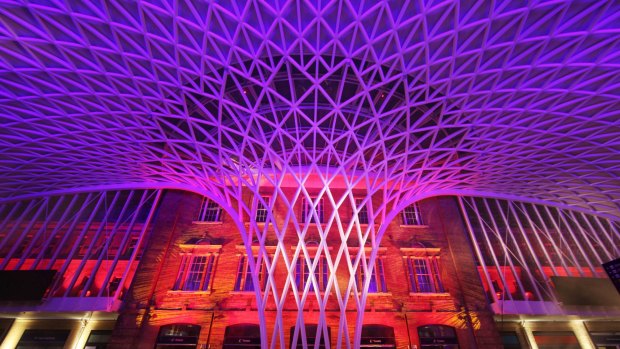
Luridly lit: Part of the King's Cross redevelopment.
It's quite something when a large swath of one of the world's top cities comes back to lurid life. It happened in London in the '70s and '80s in the docklands area, then again on the eastern fringes around Stratford in the lead-up to the Olympic Games in 2012.
Now, it's north London's turn as the streets around King's Cross and St. Pancras stations slough off their sleazy patina of pimps, pushers and prostitutes past and join the 21st century.
Just a few years ago a stroll through the area would have meant risking life and limb. Today, the worst thing you're likely to encounter is yet another skinny-jeaned fashion victim sporting Ned Kelly's head and beard.
Yes, the hustlers have given way to the hipsters. But it's not all bad news.
Plans for the £2.4 billion ($A4.4 billion), 67-acre (27 hectare) redevelopment include 2000 new homes, 50 new buildings, 20 new streets, 10 public squares and an amphitheatre made from one of the three old Victorian gasometers that used to grace the area.
The work is still ongoing but already what is now known as King's Cross Central is buzzing with energy as new offices open and people move into the apartment blocks, bringing with them the need to be fed and entertained.
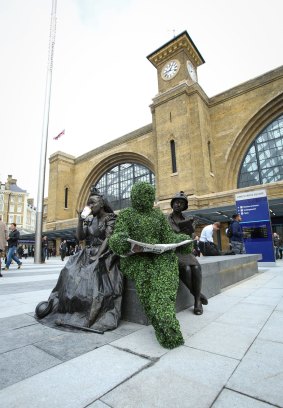
One of the sights at the King's Cross launch.
Art galleries, cafes, bars, restaurants, shops, pop-up food stalls and more public spaces with little car traffic have turned a no-go area into an increasingly popular destination, especially on summer weekends when regular public events bring people from all over the capital. These events have included a Victorian-era Steam festival, a floating cinema, a pop-up ice rink, large screens showing Wimbledon matches and regular street food markets.
And there are ghosts, too; ghosts of a past that was becoming increasingly lost as Londoners and tourists alike avoided streets that had fallen into disuse, disrepair and degradation. You can find most of them in the churchyard at St. Pancras Old Church – a roll call of luminaries such as Thomas Hardy, Sir John Soane, the iconic British telephone box and the grandmother of Frankenstein.
I learn all this and more from Sophie Campbell, a British travel journalist who has branched out to become a Blue Badge Guide – the official, professional tourist guides of the United Kingdom – and who conducts bespoke tours of the capital, including King's Cross.
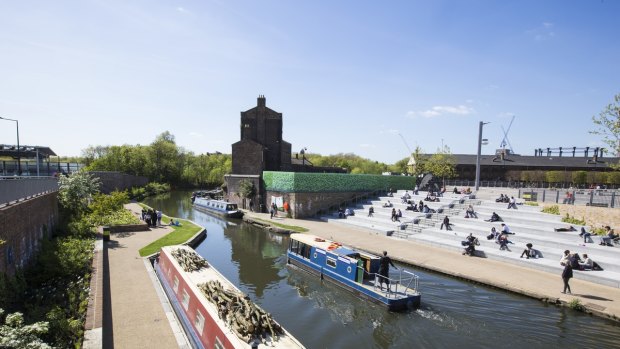
Canal cruise: A barge passes Granary Square steps in King's Cross.Credit: Keith Austin
Standing in the new, bustling pedestrian piazza outside the front of the yellow-bricked station, the first impression is that it looks a little prosaic next door to the curlicued spires of St. Pancras, its red-bricked, neo-Gothic cousin.
Campbell points out that until recently few people had actually seen the front of the station: "It suddenly appeared from beneath a 1970s fascia that stuck right out from the front of the station. Plus it was filthy."
The newly cleaned yellow brick, she explains, is stock London brick, made from the very clay beneath our feet: "It's not an attractive colour but it's our colour … and then you've got the fantastic contrast of St. Pancras next to it. Amazingly, both of them were going to be flattened in the '60s."
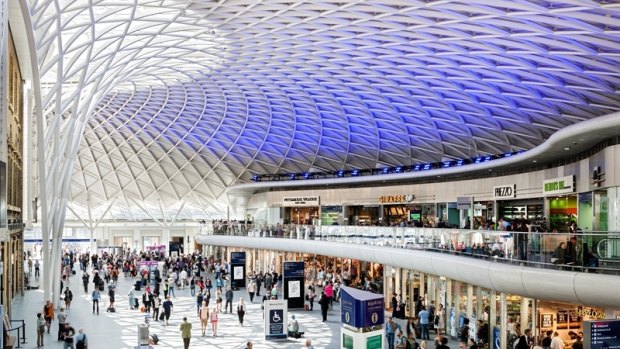
Part of the King's Cross retail redevelopment.
Unlike the original Euston station building ("very grand, neo-Classical, made of more expensive stone"), which didn't survive the '60s, determined campaigning by, among other people, the poet and writer John Betjeman, King's Cross and St. Pancras were saved from the wrecking ball. It is, says Campbell, "magic to see them coming to life again".
King's Cross was so named after King George IV, in a bid to gentrify what even then was an insalubrious area, had an 18-metre tall monument built, complete with clocks, a camera obscura on top and a statue of himself, at the crossroads of Gray's Inn Road, Pentonville Road and New Road.
It was not only huge and but also hated – a journalist of the day described it as "a ridiculous octagonal structure crowned by an absurd statue". It lasted only 15 years and was pulled down in 1845. The name, however, stuck.
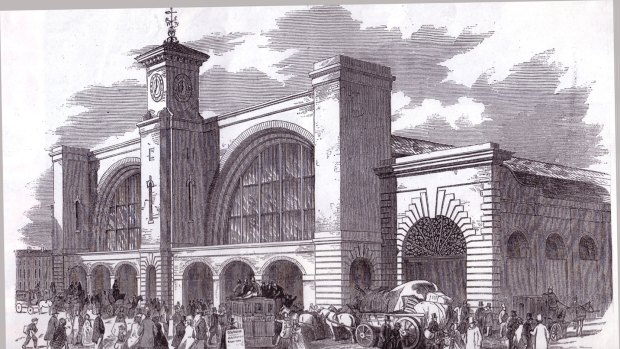
Original plans: As sketch of the first King's Cross Square Launch.
Passing through St. Pancras Station to admire the wonderfully whimsical statue of Betjeman and also Paul Day's controversial Meeting Place – a nine-metre bronze statue with a fascinating high-relief frieze on the base depicting the history of tube and train in London – we head down Pancras Road towards St Pancras old Church.
On the way we pass the site of what will eventually be The Francis Crick Institute – a biomedical research centre that, when it opens in 2015, will have 1500 staff (including 1250 scientists) and an annual budget of more than £100 million.
At the other end of the financial scale, tiny St. Pancras Old Church, a little further up the road, has a box just inside the door for any coins you might want to leave for its information pamphlets.
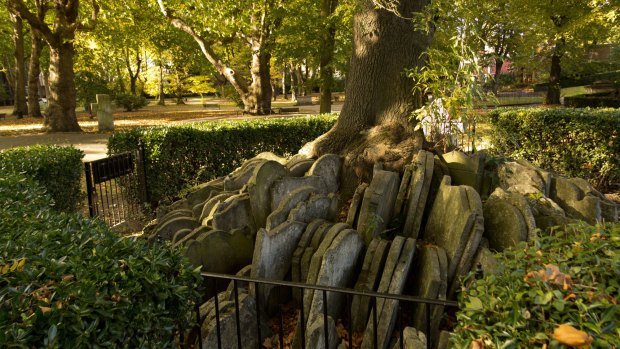
Hardy survivor: The tree and the headstones, arranged by the author as an architect.Credit: Alamy
The church is built on the site of an earlier Roman temple, and its site is said to have been a place of Christian worship since 4AD. The current building dates partially from Norman times (with major renovations in 1847, 1888 and 1925) and has, inlaid into the altar, a 6th-century stone slab from an earlier incarnation. But it is in the churchyard that the ghosts of the past await to be resurrected.
Here, you will find the bizarre Hardy Tree, a large ash circled by dozens of closely packed tombstones. Due to expansion of the Midland Railway in the 1860s part of the original churchyard was built over, occasioning the moving of many bodies. Architect Arthur Blomfield was commissioned to supervise the exhumation but passed the task to his protege, one Thomas Hardy.
Hardy, who was a trainee architect before he took to writing, decided to place the displaced headstones like spokes in a wheel around a tree that he planted. Now fenced off, the tree has grown up with its roots warped around and among the heaped memorials like tentacles.
Also in the churchyard is a monument to Sir John Soane, architect of the Bank of England, who died in 1837. The top of the monument is said to have provided inspiration to Sir Giles Gilbert Scott when he won a competition in the 1920s to design the red British telephone box.
Another memorial celebrates the life of Mary Wollstonecraft, author of A Vindication of the Rights of Woman (1792). She lived an unconventional life for the time, including indulging in two very public affairs which ruined her reputation. She died in 1797, at the age of 38, just 10 days after giving birth to Mary Wollstonecraft Godwin, who would later go on, as Mary Shelley, to write Frankenstein.
This being London, Charles Dickens, of course, gets a look-in – he lived nearby when his parents were in prison for debt, and one William Jones, whose tombstone is still here, was the inspiration for the ferocious headmaster Mr Creakle in David Copperfield.
Just past the churchyard, after ducking under the railway line that takes trains to the north and to Europe, we come upon the ornate gated entrance to Camley Street Natural Park, a narrow urban nature reserve run by the London Wildlife Trust.
It's a calm green oasis that was carved out of an old coal yard in 1984 and is popular with local schoolchildren. It runs alongside the Regent's Canal and has a new Viewpoint floating platform with stunning vistas east and west along the water.
A little further on is the new bridge over the canal, where colourful narrow boats jostle for space. On the other side is Granary Square, where the Victorian goods sheds and Granary are now full of art spaces, restaurants, shops, offices and the Central St. Martin's School of Art, which moved its main campus there in 2011.
The canal, built in 1820 and for many years a grungy no-go area, has also been spruced up and given a new lease of life
Next to them, work is ongoing at the Coal Drops. These low-rise brick and cast-iron structures were built in the 1850s to transfer coal from train wagons – which were shunted straight onto the roof – to horse-drawn carts below. Eventually they'll be restored and turned into a cobblestoned retail and leisure area with outdoor food markets and music venues.
English Heritage has called King's Cross Central one of England's 20 best heritage-led developments and, sitting in the square among the lounging art students, it's not hard to see why.
For beneath the present – where goofy dogs and giggling toddlers splash through 1080 choreographed water jets inlaid into Granary Square – the bones of the past can still be seen. Without the rickets, of course.
The writer travelled at his own expense.
TRIP NOTES
Blue Badge Guide Sophie Campbell will create a tour to fit your circumstances and interests. She can be contacted through her website Love London (love-london.com) or call +44 (0)7743 566323 or landline on +44 (0)20 7498 6589.
The King's Cross & St Pancras Business Partnership also runs several guided walking tours of the area. The tours are free but places are limited, so booking is essential. Visit kingscrossandstpancras.com for details.
MORE INFORMATION
DINING THERE
In tribute to the man who saved St. Pancras and King's Cross stations from demolition, stop off at The Betjeman Arms (geronimo-inns.co.uk/london-the-betjeman) on the upper concourse of St. Pancras, raise a glass of real ale and tuck into smoked mackerel, Cromer crab, or ham shanks.
Caravan, the popular Exmouth Market restaurant, opened a branch in the Granary building this year. Time Out raved over its own-blend coffee.
The Grain Store, a new bistro from Frenchman Bruno Loubet, opened in the Granary Building in June. Grab a table, if you can, on the outdoor, south-facing terrace.
SEE + DO
Visit London Canal Museum in Battlebridge Basin; strong on history and worth a visit for the 1860s building alone, a former warehouse for natural ice imported in bulk from Norway. See canalmuseum.org.uk.
Check out the $900 million space-age concourse attached to King's Cross Station and queue for a photograph pushing a luggage trolley through the wall at what passes for Harry Potter's platform 9 3/4.
TOURING THERE
The King's Cross Visitor Centre is in the Western Transit Shed, 11 Stable Street and is open every day except Sunday.
Sign up for the Traveller Deals newsletter
Get exclusive travel deals delivered straight to your inbox. Sign up now.